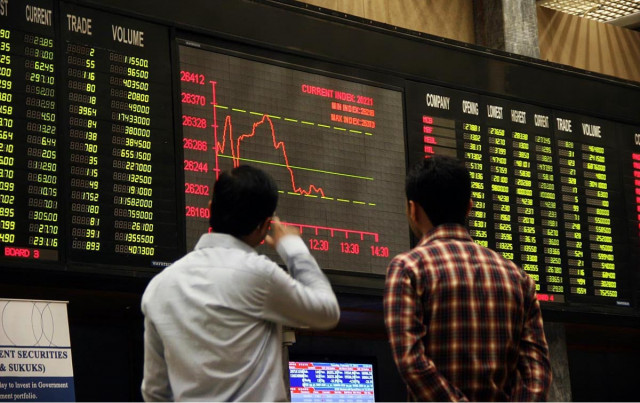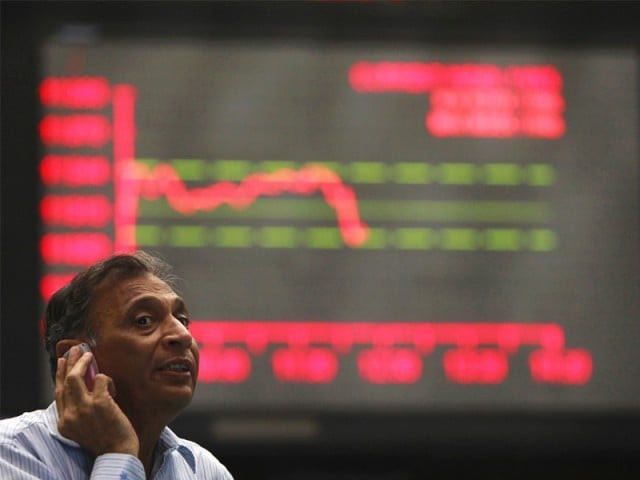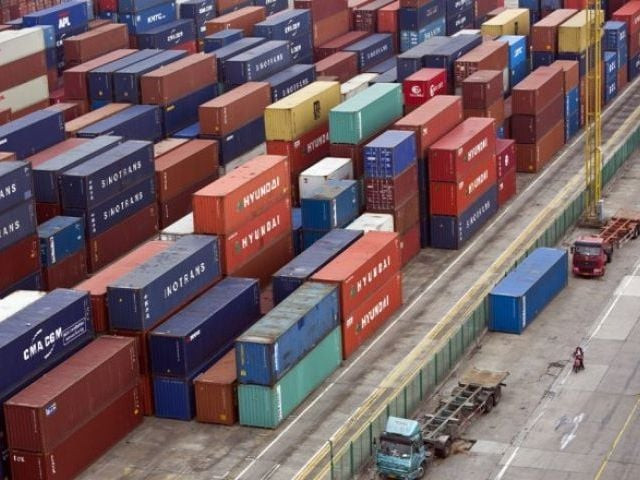Business
Global rally pushes gold to record Rs376,700 | The Express Tribune

KARACHI:
Gold prices in Pakistan surged to yet another record on Wednesday, mirroring the yellow metal’s rally in the international market, where softer US jobs data bolstered expectations of a Federal Reserve interest rate cut later this month.
Heightened global uncertainties also kept safe-haven demand strong, further fueling the uptrend. According to the All Pakistan Sarafa Gems and Jewellers Association (APSGJA), the price of gold per tola rose Rs6,000 to settle at a historic high of Rs376,700. Meanwhile, the price of 10 grams climbed Rs5,144 to Rs322,959, also an all-time high.
A day earlier, domestic gold prices had remained stable, with the per-tola rate unchanged at Rs370,700.
On the global front, gold extended its record-breaking rally as investors bet on a potential rate cut by the US Fed amid soft employment data, while persistent geopolitical and economic risks sustained demand for the precious metal.
Interactive Commodities Director Adnan Agar noted that while gold continued to gain momentum, its rally appeared “very overextended.” He highlighted that gold touched the high of $3,567 and was trading around $3,564, after hitting the low of $3,526.
“There are chances that it will make a correction after going near $3,580 or $3,600, and then it may fall back into the $3,460-3,500 range,” he said. “The upcoming US data, including key releases on Thursday and Friday, will be critical for determining the next direction for gold.” Market analysts believe that while the long-term outlook remains bullish due to global macroeconomic headwinds and investor flight to safety, short-term corrections cannot be ruled out, particularly if the upcoming US data springs a surprise and tempers rate cut expectations.
Spot gold was up 0.9% to $3,562.80 per ounce by 10:46 am EDT (1446 GMT), after hitting a record high of $3,565.57. The World Gold Council, in collaboration with law firm Linklaters and consultancy firm Hilltop Walk Consulting, has announced a new framework to modernise the global gold market, according to Reuters.
The proposal introduces a new structure called Pooled Gold Interests, which allows investors to own a share of physical gold stored in vaults, including in small, fractional amounts. The system is designed to make gold easier to trade and use, including as collateral in financial markets, and allow easy and secure transfer of gold interests between parties.
Meanwhile, the Pakistani rupee extended its upward trend against the US dollar, inching up 0.01% in the inter-bank market. By the day’s close, the currency stood at 281.71 per dollar, marking an improvement of one paisa. This also reflected the rupee’s 19th straight session of gains.
Since August 6, 2025, the local currency has appreciated a cumulative 96 paisa against the greenback. A day earlier, it had closed at 281.72.
Furthermore, the State Bank of Pakistan (SBP) raised Rs551.97 billion on Wednesday through auctions of government securities, including Rs36.74 billion via Pakistan Investment Bonds – Floating Rate (10-year) and Rs515.23 billion through Market Treasury Bills (three, six, and 12 months).
Business
Setback for expatriates? Delhi HC upholds mandatory EPFO membership; what this means for foreign staff – The Times of India

The Delhi High Court on Tuesday ruled that expatriates working in Indian companies must become members of the Employees’ Provident Fund Organisation (EPFO) and contribute to the fund regardless of their income levels.The court upheld amendments to the Employees’ Provident Funds and Miscellaneous Provisions Act, 1952, as well as the Centre’s 2008 and 2010 notifications that mandate international workers to contribute to the Employees’ Provident Fund (EPF).Under the ruling, international workers will be allowed to withdraw their full EPF balance only after retiring at or after the age of 58, or in cases of permanent and total incapacity. This is seen as a setback for expatriates who generally work in India for shorter periods of two to five years, reported ET. Indian workers, by comparison, are required to contribute if they earn below Rs 15,000 per month. Legal experts noted that many foreign employees have already left India, meaning employers will now have to bear their share of contributions.A division bench of Chief Justice Devendra Kumar Upadhyaya and Justice Tushar Rao Gedela held that the distinction between foreign and Indian employees was justified. The court accepted the government’s position that international workers form a separate group because they contribute only during their limited time in India, unlike domestic employees who contribute throughout their service.“The classification made was reasonable and it also has an object sought to be achieved that the purpose of mandating an employee to be a member of 1952 scheme was to provide social security,” the court said, as quoted by ET.The court also upheld EPFO communications directing SpiceJet and LG Electronics India to deposit provident fund and related dues for their international staff. It dismissed SpiceJet’s challenge to summons issued in 2012 requiring it to produce records for determining liabilities, and similarly rejected objections raised by LG Electronics.The Delhi High Court’s ruling aligns with a previous judgment of the Bombay High Court, while the Karnataka High Court has ruled to the contrary. Due to the conflicting views, the matter is expected to reach the Supreme Court for final interpretation. Both companies are assessing the implications and are likely to move to the Supreme Court, according to legal sources.Atul Sharma, counsel for SpiceJet, said, “The entire basis of amendment to the scheme is implementation to certain treaties with countries who have similar provision for social security. And under the Constitution of India, this amendment could not be implemented as treaties have not been ratified by Parliament.” He said the issue requires further consideration.The companies had argued that the classification between foreign and Indian employees was discriminatory.
Business
GST rationalisation impact: Higher RBI dividend expected to offset revenue shortfall; CareEdge flags tax pressure – The Times of India

The recent rationalisation of Goods and Services Tax (GST) rates is likely to create a net revenue loss of around 0.1 per cent of GDP in the current financial year. However, this shortfall may be compensated by the higher dividend payout from the Reserve Bank of India (RBI), according to a report by CareEdge Ratings.The report, cited by ANI, highlighted that tax revenue growth has already slowed this year. With nominal GDP growth projected to be lower in FY26, achieving the full-year tax collection targets could become more difficult. The effect of the income tax relief announced in the last Budget, along with the revised GST structure, will need to be closely watched in the coming months.
CareEdge noted, “The net revenue shortfall from GST rationalisation is expected to be offset by the higher dividend transfer received from the RBI.”Despite the support from non-tax revenue, the report cautioned that weaker tax inflows could limit the government’s spending capacity in the latter half of the fiscal year. This could become more pronounced if the Centre continues to focus on its fiscal consolidation goal, which involves gradually lowering the fiscal deficit over time.When the GST rationalisation decision was announced, the GST Council had estimated the fiscal implication at about Rs 48,000 crore, or around 0.15 per cent of GDP based on FY24 consumption levels. The Council had also expected that stronger consumption could help recover part of this impact through improved GST receipts.A separate analysis by the State Bank of India (SBI), reported by ANI, projected that the central government’s revenue loss due to the GST rate cuts will be about Rs 3,700 crore in FY26. SBI noted that robust growth and increased consumer demand have helped soften the overall impact.SBI pointed out that while the initial estimated loss from GST rate changes was Rs 93,000 crore, additional GST collections led to the net loss narrowing to Rs 48,000 crore.During the first half of the current fiscal year, a slowdown in tax receipts was partly cushioned by strong non-tax revenue, particularly the higher dividend from the RBI. Meanwhile, the reduction in personal income tax rates announced in the Budget has contributed to slower income tax collections this year.While the complete fiscal impact of the GST rationalisation will become clearer over time, analysts suggest that the government may still be able to maintain fiscal balance. The combination of higher non-tax revenue and potential gains from stronger consumption-led GST inflows could help offset the pressure from moderating tax collections.
Business
Novo Nordisk cuts sales and profits guidance amid obesity drug competition

The drugmaker behind Ozempic and Wegovy has cut its sales and profit targets in the face of intense competition from other weight-loss and diabetes treatments.
Novo Nordisk warned over weaker-than-expected profits amid the recent growth of US rival Eli Lilly’s Mounjaro and Zepbound injection treatments.
The boss of the Danish pharmaceutical firm linked its reduced guidance to the market for weight-loss treatments being “more competitive than ever”.
Mike Doustdar, chief executive of Novo Nordisk, said: “While we delivered robust sales growth in the first nine months of 2025, the lower growth expectations for our GLP-1 treatments, for diabetes and obesity, have led to a narrowing of our guidance.”
The firm said sales are set to rise by up to 11% this year. It had previously guided towards growth of up to 14%.
It also reported that operating profits will rise by up to 7% this year, pulling down its previous guidance of up to 10%.
It came as the business reported that sales in its diabetes and obesity care division grew by 12% in Danish kroner, or 15% at constant currency rates, over the first nine months of 2025.
This included a stronger performance across obesity, with 7% growth in the diabetes-focused part of the division, which includes Ozempic.
Meanwhile, operating profits grew by 5%, or 10% at constant currency rates, for the year so far.
It said this included a nine billion kroner (£6.7 billion) impact from one of restructuring costs.
This came after the company launched a major overhaul in September, which included plans to cut around 9,000 jobs globally.
Mr Doustdar added: “Our company-wide transformation has already driven operational efficiencies, and we have a renewed focus that can deliver a range of potential treatment options that will serve millions more patients, mainly in obesity.
“We aim to accelerate on all fronts to be able to compete better in dynamic and increasingly competitive markets.”
-

 Tech1 week ago
Tech1 week agoOpenAI says a million ChatGPT users talk about suicide
-

 Tech1 week ago
Tech1 week agoUS Ralph Lauren partners with Microsoft for AI shopping experience
-

 Tech1 week ago
Tech1 week agoHow digital technologies can support a circular economy
-

 Sports1 week ago
Sports1 week agoBilly Bob Thornton dishes on Cowboys owner Jerry Jones’ acting prowess after ‘Landman’ cameo
-

 Tech1 week ago
Tech1 week agoAI chatbots are becoming everyday tools for mundane tasks, use data shows
-

 Fashion1 week ago
Fashion1 week agoITMF elects new board at 2025 Yogyakarta conference
-

 Business1 week ago
Business1 week agoTransfer test: Children from Belfast low income families to be given free tuition
-

 Business1 week ago
Business1 week agoLucid targets industry-first self-driving car technology with Nvidia












